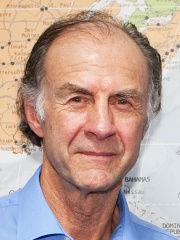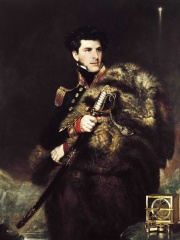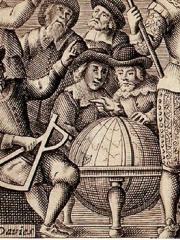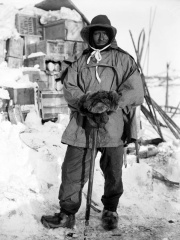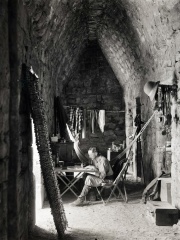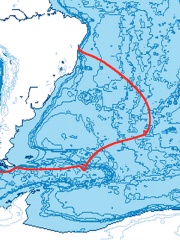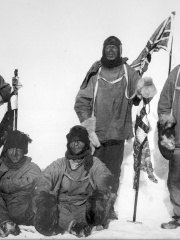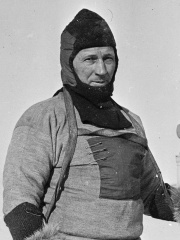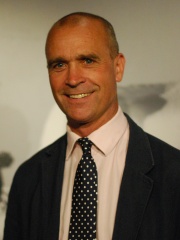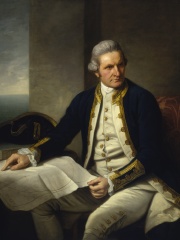
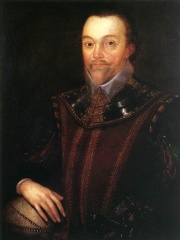
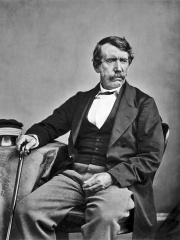
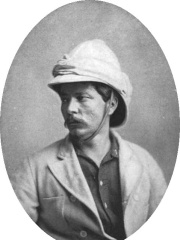
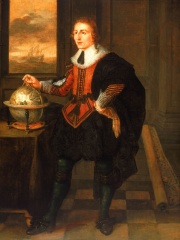
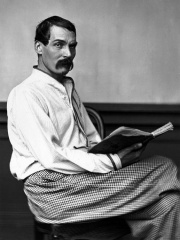
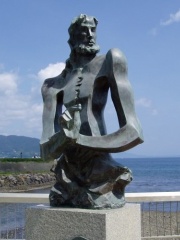
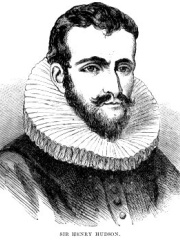
The Most Famous
EXPLORERS from United Kingdom
This page contains a list of the greatest British Explorers. The pantheon dataset contains 405 Explorers, 80 of which were born in United Kingdom. This makes United Kingdom the birth place of the most number of Explorers.
Top 10
The following people are considered by Pantheon to be the top 10 most legendary British Explorers of all time. This list of famous British Explorers is sorted by HPI (Historical Popularity Index), a metric that aggregates information on a biography’s online popularity. Visit the rankings page to view the entire list of British Explorers.

1. James Cook (1728 - 1779)
With an HPI of 82.31, James Cook is the most famous British Explorer. His biography has been translated into 151 different languages on wikipedia.
Captain James Cook (7 November [O.S. 27 October] 1728 – 14 February 1779) was a British explorer, cartographer and naval officer famous for his three voyages between 1768 and 1779 in the Pacific Ocean and to New Zealand and Australia in particular. He made detailed maps of Newfoundland prior to making three voyages to the Pacific, during which he achieved the first recorded European contact with the eastern coastline of Australia and the Hawaiian Islands and the first recorded circumnavigation of New Zealand. Cook joined the British merchant navy as a teenager and joined the Royal Navy in 1755. He served during the Seven Years' War and subsequently surveyed and mapped much of the entrance to the St. Lawrence River during the siege of Quebec, which brought him to the attention of the Admiralty and the Royal Society. This acclaim came at a crucial moment for the direction of British overseas exploration, and it led to his commission in 1768 as commander of HMS Endeavour for the first of three Pacific voyages. In these voyages, Cook sailed thousands of miles across largely uncharted areas of the globe. He mapped lands from New Zealand to Hawaii in the Pacific Ocean in greater detail and on a scale not previously charted by Western explorers. He surveyed and named features, and recorded islands and coastlines on European maps for the first time. He displayed a combination of seamanship, superior surveying and cartographic skills, physical courage, and an ability to lead men in adverse conditions. During his third voyage in the Pacific, Cook encountered the Hawaiian islands in 1779. He was killed while attempting to take hostage Kalaniʻōpuʻu, chief of the island of Hawaii, during a dispute. He left a legacy of scientific and geographical knowledge that influenced his successors well into the 20th century, and numerous memorials worldwide have been dedicated to him. He remains controversial as an enabler of British colonialism and for his occasionally violent encounters with indigenous peoples.

2. Francis Drake (1540 - 1596)
With an HPI of 79.36, Francis Drake is the 2nd most famous British Explorer. His biography has been translated into 108 different languages.
Sir Francis Drake (c. 1540 – 28 January 1596) was an English explorer and privateer best known for his circumnavigation of the world in a single expedition between 1577 and 1580. This was the first English circumnavigation, and third circumnavigation overall. He is also known for participating in the early English slaving voyages of his cousin, Sir John Hawkins, and John Lovell. Having started as a simple seaman, in 1588 he was part of the fight against the Spanish Armada as a vice-admiral. At an early age, Drake was placed into the household of a relative, William Hawkins, a prominent sea captain in Plymouth. In 1572, he set sail on his first independent mission, privateering along the Spanish Main. Drake's circumnavigation began on 15 December 1577. He crossed the Pacific Ocean, until then an area of exclusive Spanish interest, and laid claim to New Albion, plundering coastal towns and ships for treasure and supplies as he went. He arrived back in England on 26 September 1580. Elizabeth I awarded Drake a knighthood in 1581 which he received aboard his galleon the Golden Hind. Drake's circumnavigation inaugurated an era of conflict with the Spanish and in 1585, the Anglo-Spanish War began. Drake was in command of an expedition to the Americas that attacked Spanish shipping and ports. When Philip II sent the Spanish Armada to England in 1588 as a precursor to its invasion, Drake was second-in-command of the English fleet that fought against and repulsed the Spanish fleet. A year later he led the English Armada in a failed attempt to destroy the remaining Spanish fleet. Drake was the Member of Parliament (MP) for three constituencies: Camelford in 1581, Bossiney in 1584, and Plymouth in 1593. Drake's exploits made him a hero to the English, but his privateering led the Spanish to brand him a pirate, known to them as El Draque ("The Dragon" in old Spanish). He died of dysentery after his failed assault on Panama in January 1596.

3. David Livingstone (1813 - 1873)
With an HPI of 76.77, David Livingstone is the 3rd most famous British Explorer. His biography has been translated into 85 different languages.
David Livingstone (; 19 March 1813 – 1 May 1873) was a Scottish physician, Congregationalist, pioneer Christian missionary with the London Missionary Society, and an explorer in Africa. Livingstone was married to Mary Moffat Livingstone, from the prominent 18th-century Moffatt missionary family. Livingstone came to have a mythic status that operated on a number of interconnected levels: Protestant missionary martyr, working-class "rags-to-riches" inspirational story, scientific investigator and explorer, imperial reformer, anti-slavery crusader, and advocate of British commercial and colonial expansion. As a result, Livingstone became one of the most popular British heroes of the late 19th-century Victorian era. Livingstone's fame as an explorer and his obsession with learning the sources of the Nile River was founded on the belief that if he could solve that age-old mystery, his fame would give him the influence to end the East African Arab–Swahili slave trade. "The Nile sources", he told a friend, "are valuable only as a means of opening my mouth with power among men. It is this power [with] which I hope to remedy an immense evil." His subsequent exploration of the central African watershed was the culmination of the classic period of European geographical discovery and colonial penetration of Africa. At the same time, his missionary travels, "disappearance", and eventual death in Africa—and subsequent glorification as a posthumous national hero in 1874—led to the founding of several major central African Christian missionary initiatives carried forward in the era of the European "Scramble for Africa".

4. Henry Morton Stanley (1841 - 1904)
With an HPI of 70.20, Henry Morton Stanley is the 4th most famous British Explorer. His biography has been translated into 65 different languages.
Sir Henry Morton Stanley (born John Rowlands; 28 January 1841 – 10 May 1904) was a Welsh-American explorer, journalist, soldier, colonial administrator, author and politician who was famous for his exploration of Central Africa and his search for missionary and explorer David Livingstone. Besides his discovery of Livingstone, he is mainly known for his search for the sources of the Nile and Congo rivers, the work he undertook as an agent of King Leopold II of the Belgians which enabled the occupation of the Congo Basin region, and his command of the Emin Pasha Relief Expedition. He was knighted in 1897, and served in Parliament as a Liberal Unionist member for Lambeth North from 1895 to 1900. More than a century after his death, Stanley's legacy remains the subject of enduring controversy. Although he personally had high regard for many of the native African people who accompanied him on his expeditions,: 10–11 the exaggerated accounts of corporal punishment and brutality in his books fostered a public reputation as a hard-driving, cruel leader,: 201–202 in contrast to the supposedly more humanitarian Livingstone.: 472 His contemporary image in Britain also suffered from the inaccurate perception that he was American. In the 20th century, his reputation was also seriously damaged by his role in establishing the Congo Free State for King Leopold II.: 7 Nevertheless, he is recognised for his important contributions to Western knowledge of the geography of Central Africa and for his resolute opposition to the slave trade in East Africa.: 16, 474
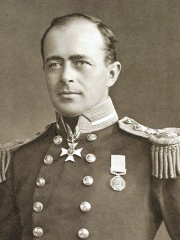
5. Robert Falcon Scott (1868 - 1912)
With an HPI of 67.79, Robert Falcon Scott is the 5th most famous British Explorer. His biography has been translated into 65 different languages.
Captain Robert Falcon Scott (6 June 1868 – c. 29 March 1912) was a British Royal Navy officer and explorer who led two expeditions to the Antarctic regions: the Discovery expedition of 1901–04 and the Terra Nova expedition of 1910–13. On the first expedition, he set a new southern record by marching to latitude 82°S and discovered the Antarctic Plateau, on which the South Pole is located. On the second venture, Scott led a party of five which reached the South Pole on 17 January 1912, less than five weeks after Amundsen's South Pole expedition. A planned meeting with supporting dog teams from the base camp failed, despite Scott's written instructions, and at a distance of 162 miles (261 km) from their base camp at Hut Point and approximately 12.5 miles (20.1 km) from the next depot, Scott and his companions died. When Scott and his party's bodies were discovered, they had in their possession the first Antarctic fossils discovered. The fossils were determined to be from the Glossopteris tree and proved that Antarctica was once forested and joined to other continents. Before his appointment to lead the Discovery expedition, Scott had a career as a Royal Navy officer. In 1899, he had a chance encounter with Sir Clements Markham, the president of the Royal Geographical Society, and learned of a planned Antarctic expedition, which he soon volunteered to lead. His name became inseparably associated with the Antarctic, the field of work to which he remained committed during the final 12 years of his life. Following the news of his death, Scott became a celebrated hero, a status reflected by memorials erected across the UK. However, in the last decades of the 20th century, questions were raised about his competence and character. Commentators in the 21st century have regarded Scott more positively after assessing the temperature drop below −40 °C (−40 °F) in March 1912, and after re-discovering Scott's written orders of October 1911, in which he had instructed the dog teams to meet and assist him on the return trip.

6. William Baffin (1584 - 1622)
With an HPI of 66.02, William Baffin is the 6th most famous British Explorer. His biography has been translated into 49 different languages.
William Baffin (c. 1584 – 23 January 1622) was an English navigator, explorer and cartographer. He is primarily known for his attempt to find a Northwest Passage from the Atlantic to the Pacific, during the course of which he was the first European to discover Baffin Bay situated between Canada and Greenland. He was also responsible for exceptional surveys of the Red Sea and Persian Gulf on behalf of the East India Company.

7. Richard Francis Burton (1821 - 1890)
With an HPI of 65.05, Richard Francis Burton is the 7th most famous British Explorer. His biography has been translated into 52 different languages.
Sir Richard Francis Burton (; 19 March 1821 – 20 October 1890) was a British explorer, writer, orientalist scholar, and soldier. He was famed for his travels and explorations in Asia, Africa, and the Americas, as well as his extraordinary knowledge of languages and cultures. According to one count, Burton spoke 29 languages.Burton's best-known achievements include: a well-documented journey to Mecca in disguise, at a time when non-Muslims were forbidden access on pain of death; an unexpurgated translation of One Thousand and One Nights (commonly called The Arabian Nights in English after early translations of Antoine Galland's French version); the publication of the Kama Sutra in English; a translation of The Perfumed Garden, the "Arab Kama Sutra"; and a journey with John Hanning Speke as the first Europeans to visit the Great Lakes of Africa in search of the source of the Nile. His works and letters extensively criticised colonial policies of the British Empire, even to the detriment of his career. Although he aborted his university studies, he became a prolific and erudite author and wrote numerous books and scholarly articles about subjects including human behaviour, travel, falconry, fencing, sexual practices, and ethnography. A characteristic feature of his books is the copious footnotes and appendices containing remarkable observations and information. William Henry Wilkins wrote: "So far as I can gather from all I have learned, the chief value of Burton’s version of The Scented Garden lay not so much in his translation of the text, though that of course was admirably done, as in the copious notes and explanations which he had gathered together for the purpose of annotating the book. He had made this subject a study of years. For the notes of the book alone he had been collecting material for thirty years, though his actual translation of it only took him eighteen months."Burton was a captain in the army of the East India Company, serving in India, and later briefly in the Crimean War. Following this, he was engaged by the Royal Geographical Society to explore the east coast of Africa, where he led an expedition guided by locals and was the first European known to have seen Lake Tanganyika. In later life, he served as British consul in Fernando Pó (now Bioko, Equatorial Guinea), Santos in Brazil, Damascus (now Syria), and finally in Trieste (now Italy). He was a Fellow of the Royal Geographical Society and was awarded a knighthood in 1886.

8. William Adams (1564 - 1620)
With an HPI of 64.94, William Adams is the 8th most famous British Explorer. His biography has been translated into 29 different languages.
William Adams (Japanese: ウィリアム・アダムス, Hepburn: Uwiriamu Adamusu, kyūjitai: ウヰリアム・アダムス; 24 September 1564 – 16 May 1620), better known in Japan as Miura Anjin (三浦按針, 'the pilot of Miura'), was an English navigator who, in 1600, became the first Englishman to reach Japan. He did so on a trading ship called Liefde under the leadership of Jacob Quaeckernaeck; it was the only vessel reaching Japan from a five-ship expedition launched by a company of Rotterdam merchants (a voorcompagnie, or predecessor of the Dutch East India Company). Among the few survivors of the expedition who reached Japan, for more than a decade, the authorities did not allow Adams and his second mate Jan Joosten to leave the country. Earlier, they did permit Quaeckernaeck and Melchior van Santvoort to return to the Dutch Republic to establish formal trade relations. Adams and Joosten settled in Japan, and the two men became Western samurai. Soon after Adams' arrival in Japan, he became a key advisor to the shōgun Tokugawa Ieyasu. Under his authority, Adams directed construction of the first Western-style ships in the country. He was later part of Japan's approving the establishment of trading factories by the Netherlands. Although eventually given permission to return home to England, he ultimately decided to stay in Japan. He became highly involved in Japan's red seal trade, chartering and serving as captain of four expeditions to Southeast Asia. He died in Japan at age 55. He has been recognized as one of the most influential foreigners in Japan during this period.

9. Henry Hudson (1570 - 1611)
With an HPI of 64.35, Henry Hudson is the 9th most famous British Explorer. His biography has been translated into 64 different languages.
Henry Hudson (c. 1565 – disappeared 23 June 1611) was an English sea explorer and navigator during the early 17th century, best known for his explorations of present-day Canada and parts of the northeastern United States. In 1607 and 1608, Hudson made two attempts on behalf of English merchants to find a rumoured Northeast Passage to Cathay via a route above the Arctic Circle. In 1609, he landed in North America on behalf of the Dutch East India Company and explored the region around the modern New York metropolitan area. Looking for a Northwest Passage to Asia on his ship Halve Maen ("Half Moon"), he sailed up the Hudson River, which was later named after him, and thereby laid the foundation for Dutch colonization of the region. His contributions to the exploration of the New World were significant and lasting. His voyages helped to establish European contact with the native peoples of North America and contributed to the development of trade and commerce. On his final expedition, while still searching for the Northwest Passage, Hudson became the first European to see Hudson Strait and the immense Hudson Bay. In 1611, after wintering on the shore of James Bay, Hudson wanted to press on to the west, but most of his crew mutinied. The mutineers cast Hudson, his son, and six others adrift; the Hudsons and their companions were never seen again.
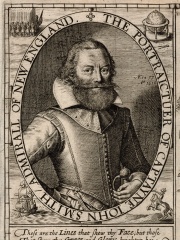
10. John Smith (1580 - 1631)
With an HPI of 63.88, John Smith is the 10th most famous British Explorer. His biography has been translated into 39 different languages.
John Smith (baptized 6 January 1580 – 21 June 1631) was an English soldier, explorer, colonial governor, admiral of New England, and author. He played an important role in the establishment of the colony at Jamestown, Virginia, the first permanent English settlement in North America, in the early 17th century. He was a leader of the Virginia Colony between September 1608 and August 1609, and he led an exploration along the rivers of Virginia and the Chesapeake Bay, during which he became the first English explorer to map the Chesapeake Bay area. Later, he explored and mapped the coast of New England. He was knighted for his services to Sigismund Báthory, Prince of Transylvania, and his friend Mózes Székely. Jamestown was established on May 14, 1607. Smith trained the first settlers to work at farming and fishing, thus saving the colony from early devastation. He publicly stated, "He that will not work, shall not eat", alluding to 2 Thessalonians 3:10. Harsh weather, a lack of food and water, the surrounding swampy wilderness, and attacks from Native Americans almost destroyed the colony. With Smith's leadership, however, Jamestown survived and eventually flourished. Smith was forced to return to England after being injured by an accidental explosion of gunpowder in a canoe. Smith's books and maps were important in encouraging and supporting English colonization of the New World. Having named the region of New England, he stated: "Here every man may be master and owner of his owne labour and land. ...If he have nothing but his hands, he may...by industries quickly grow rich." Smith died in London in 1631.
Pantheon has 80 people classified as explorers born between 1521 and 1976. Of these 80, 3 (3.75%) of them are still alive today. The most famous living explorers include Ranulph Fiennes, Ed Stafford, and Ellen MacArthur. The most famous deceased explorers include James Cook, Francis Drake, and David Livingstone. As of April 2022, 7 new explorers have been added to Pantheon including Edgar Evans, Alfred Maudslay, and Anthony de la Roché.
Living Explorers
Go to all Rankings
Ranulph Fiennes
1944 - Present
HPI: 45.82
Ed Stafford
1975 - Present
HPI: 42.64
Ellen MacArthur
1976 - Present
HPI: 36.09

Deceased Explorers
Go to all Rankings
James Cook
1728 - 1779
HPI: 82.31
Francis Drake
1540 - 1596
HPI: 79.36
David Livingstone
1813 - 1873
HPI: 76.77
Henry Morton Stanley
1841 - 1904
HPI: 70.20
Robert Falcon Scott
1868 - 1912
HPI: 67.79
William Baffin
1584 - 1622
HPI: 66.02
Richard Francis Burton
1821 - 1890
HPI: 65.05
William Adams
1564 - 1620
HPI: 64.94
Henry Hudson
1570 - 1611
HPI: 64.35
John Smith
1580 - 1631
HPI: 63.88
James Clark Ross
1800 - 1862
HPI: 63.77
John Davis
1550 - 1605
HPI: 63.18

Newly Added Explorers (2022)
Go to all Rankings
Edgar Evans
1876 - 1912
HPI: 47.36
Alfred Maudslay
1850 - 1931
HPI: 46.57
Anthony de la Roché
1700 - Present
HPI: 45.95
Henry Robertson Bowers
1883 - 1912
HPI: 45.73
William Lashly
1867 - 1940
HPI: 42.72
Bartholomew Gosnold
1572 - 1607
HPI: 40.81
Henry Worsley
1960 - 2016
HPI: 32.85

Which Explorers were alive at the same time? This visualization shows the lifespans of the 25 most globally memorable Explorers since 1700.

